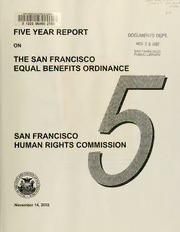
Five year report on the San Francisco equal benefits ordinance PDF
Preview Five year report on the San Francisco equal benefits ordinance
SANFRANCISCOPUBLICLIBRAR 3 1223 06460 2783 YEAR REPORT FIVE DOCUMENTS DEPT. ON NOV 1 3 2002 SAN FRANCISCO PUBLIC LIBRARY THE SAN FRANCISCO EQUAL BENEFITS ORDINANCE SAN FRANCISCO HUMAN RIGHTS COMMISSION November 14, 2002 San FranciscoPublicLibrary Gove erflw 8c: REFERENCE BOOK Not fo be taken from the Library Virginia M. Harmon Director Report prepared by: Cynthia G. Goldstein, Senior Contract Compliance Officer with assistance from other members of the staff of The Lesbian Gay Bisexual Transgender & HIV Division Marcus Arana, Representative Larry Brinkin, Senior Contract Compliance Officer Kabir Hypolite, Contract Compliance Officer Yong Lee, Contract Compliance Officer Ellise Nicholson, Representative Hadas Rivera-Weiss, Representative David Treanor, Senior Management Assistant Domenic Viterbo, Administrative Assistant Tamra Winchester, Contract Compliance Officer Digitized by the Internet Archive in 2012 with funding from California State Library Califa/LSTA Grant http://archive.org/details/fiveyearreporton2002huma TABLE OF CONTENTS Executive Summary I. 1 Compliance Update 2 II. A. Employers Offering Domestic Partner Benefits 2 B. Complying Companies 3 C. Compliance By Type 3 D. Company Size 4 E. Employees Covered 5 F. Companies Limiting Compliance 5 G. Geography 6 H. Waivers 7 Insurance Industry 9 I. 111. Legislative Update 10 A. Contracting Legislation 10 B. Domestic Partnership Registries 11 C. California Domestic Partnership Legislation 11 D. Domestic Partnership Rights in San Francisco 12 IV. Litigation Update 12 A. Air Transport Association 12 B. Religious-Based Lawsuits 13 V. Impact of Ordinance 13 Appendix A. Resource Materials 3 1223 06460 2783 - Executive Summary I. D - June 1 1 997, the City and Count) of 3an Francisco set in motion a revolution. With Its longstanding history of anti-discrimination laws as a rjundatit- San Francisco enactet the rs: = -re _rtec 5:a:es :t stress : ss a:;- - e~t t,.ee ze-e*ts tr e~: s.ees .«.:- tt~ests zatre-s ^e-e-ez r as re Ez_a Ee-e-":s Z'z -are re a.', ei, -es 3a- Franciscc's City contractors to provide the sa~e ze-efits to employees who have domestic ~ :a--e-r a- : e~t : ..ees -sa-e~a~et _ s 'est - tea a: re ~-=: * e ..ea's r' implementation -studying the law's impact in 3 a- -a-zscoand across the zzrtry. Des: :e the fad thai :_e zoncep: r" :~en'ng domes: : :a-tner benefits to employees was a«lwr«neaaV,dm.y.nl.on_v\_e/.ra_ra_cdioniztHetiBn^ WyI .eOaQ.rsUol—_d_—a_t.-_t-zh.e_—tim-ze.-tzh5.e-H-OEz.qu~Ia1—lWBBz.]ene~-fit—-s- JO.r-d~i~na—_nce_w_a.sz.-ze.nza.c-.tz.ed_,.o-n_zlzyz benefits. The San Francisco Equal Benefits Ordinance -as teen credited v. thptaynga major role in this explosion of domes: t t atner benefits" with over 75% ofthe companies offering domestic partner benefits doing so in compliance with the City's contraring requirements. During the first five years of implementation, the concept of employe provided domestic partner benefits moved from the farfringes ofthe fringe-benefl landscape to become commonplace among employee benefits offerings. ~~e --~:e- r e~t t .ees t,z~<.-z zz'Z'~. tc-rattrs :_a: -a.e _: zez ~ez ta te'ers rr re - :t~estt zatre's _ as srz asset 53 \\\ a_ t :a_ tet__ t - a: eas: 2 3 s:a:es a_ t 5C2 ttes artss re ttrtt E.e- .•. -e~ a . ea- a~e- _e s e_: _r e~ett a tct decision gave companies the option to limitwhere they extended nondiscrimffiatory te-ers -s: :.er re zeter r :_e ::~t -: :r-za- es riser tt st 2pq=;23te r r .".' 7;' ' -f rr'Zir r"z "~t2:~-'z~~:ZZ :eTthes num-'"b:ear_:o..fzgo_v"etrnrmeenttaasl: Ee~e~s Z". -=-:= z s.~z a -r — = - r. z -z ;. ~azc- -~z--re zs~37: e<za-sc- :-' Z-z ~'zr- a ~Z~.eZ~. ~Z "r ' Z"S z~ ZZ~rl~ : Zz~~z~Z "" "5C S" ^^^^™^^^^^^^^^^ ~^~~^~~_^^ t ~re —a~t ~re ^^~^-\ r:s '.:.- : st~e r re -crs asszt a.:ez aats opportunity for domestic partners to identify themselves in the U.S. Census, gn In rr Sin 7r^:;:i;: recxzie ±r ±r: ;: erzme-: -u:V"::5: ~~ _i : _ i 5 7 -..- - -j .'.:; 7.::- 17 : : 1 "": . 7:1—~:" : it'Z :i S. V : "1 ~ 1~ . : - .." T:": : : . . :- m - : i :_-; _ir :: ;m:; ;- . . . :_ : ;- :.7 :- I- . ; 7~i_; -;.-:;;::v. -i~z- -=.i :~~ :: :-;; :: number of domestic partnerships cannot be disputed. In fact, the 2000 Census noted the presence of same-sex domestic partnerships in all Congressional districts and in all but 22 counties in the entire United States. Even as the U.S. economy has experienced a downturn, the number of City contractors extending domestic partner benefits continues to increase and the use of waivers to contract with non-compliant companies steadily decreases. Also impressive in this economic climate, is the continued growth in the number of other cities across the United States enacting Equal Benefits Ordinances in theirjurisdictions.5 Compliance Update II. This report examines the implementation effort of fiscal year 2001-2002 as well as the impact and performance of the Equal Benefits Ordinance since its enactment five years ago. A. Employers Offering Domestic Partner Benefits From the first offering of domestic partner benefits by the Village Voice Newspaper in 1982 until the introduction of the Equal Benefits Ordinance fifteen years later, only 500 companies extended domestic partner benefits to their employees. Five years later, that number has surged. As of June 30, 2002, the Human Rights Commission helped 3,500 City Contractors extend benefits to the domestic partners of their employees. Nationwide, over 4,500 employers have been documented as offering such benefits. (See Fig. 1.) Employers Offering Domestic Partner Benefits Nationwide 1982-2002 JUUU 4000 /™^ 3,500 City Contractors Offering 3000 / Domestic Partner Benefits 2000 1000 ^__ I 1980 1985 1990 1995 2000 2005 Equal Benefits Ordinance Enacted Fig. 1 See page 10 for a list ofjurisdictionswith EqualBenefits Ordinances.
